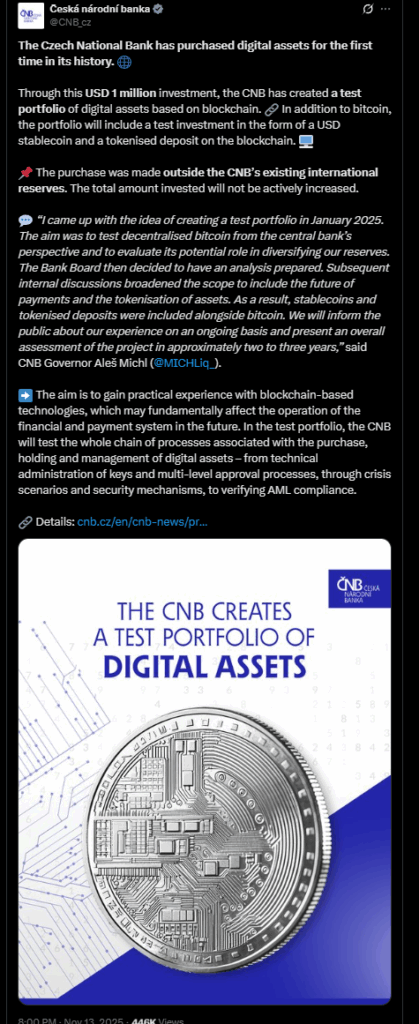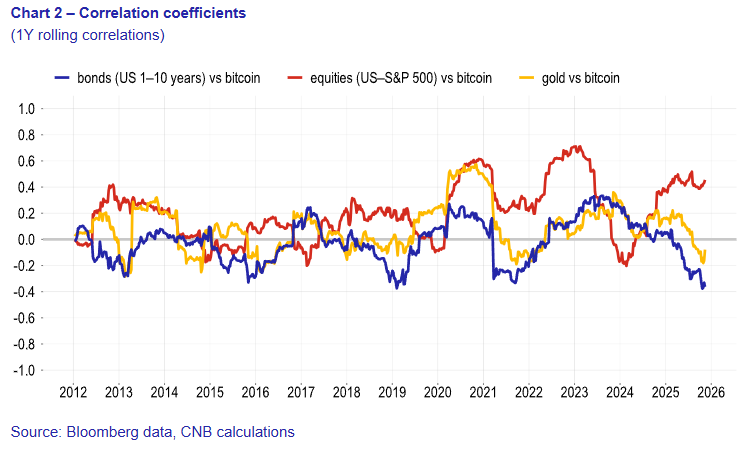- The Czech National Bank created a $1M test portfolio containing Bitcoin, a stablecoin, and a tokenized dollar deposit — its first direct crypto purchase.
- The project will run through 2027–2028 to study custody, payments, tokenization, and regulatory compliance, with the assets held outside official reserves.
- The initiative comes as European institutions expand MiCA-aligned crypto services, signaling growing institutional interest in digital assets.
The Czech National Bank just made a move nobody really expected from such a conservative institution: it bought Bitcoin. Well—not a massive pile of it, but a $1 million digital asset test portfolio that includes BTC, a USD-pegged stablecoin, and even a tokenized dollar deposit. For the CNB, this is its first-ever direct purchase of crypto, marking a pretty meaningful step into the digital asset world even if the amount looks tiny on paper.

Why the CNB Created This Portfolio
The CNB Bank Board approved the portfolio on October 30, but made it very clear that the funds will be held outside foreign reserves with no intention of scaling it up—at least not for now. Governor Aleš Michl actually pitched the idea back in January 2025 to help the bank understand how Bitcoin, tokenization, and other emerging payment systems might shape the financial future. It’s less about speculation and more about learning, testing, and staying ahead of whatever digital finance becomes.
To manage the experiment, the CNB set up something called the CNB Lab, its own innovation hub. Besides the portfolio itself, the lab is also watching AI use cases, new payment rails, and other tech trends. Before going live, the project went through a full risk assessment that compared different crypto categories and the potential exposures they bring. And just to show how small this really is: the entire portfolio represents only 0.0006% of the CNB’s total assets.
Europe’s Regulatory Backdrop and What’s Being Tested
The CNB’s experiment is unfolding while Europe’s regulatory environment shifts fast. Banks like AMINA have already secured MiCA-compliant crypto permissions, and institutions such as Standard Chartered and OKX are expanding digital asset services across the EEA. So the CNB is stepping in at a moment when traditional finance is starting to blend with tokenized systems more aggressively.
The evaluation itself isn’t just about price performance. The bank wants to test real operational details — custody solutions, transaction handling, security controls, compliance workflows — basically all the unglamorous but essential parts of running digital assets inside a regulated institution. For accounting purposes, the CNB is classifying the portfolio as an intangible asset, keeping it separate from standard reserve management.
What Happens Next
This isn’t a short trial either. The project runs through 2027–2028, after which the bank will decide whether the whole thing gets expanded, modified, or quietly shut down. By then, crypto regulations in Europe will be clearer, tokenized financial products should be more mature, and central banks worldwide will have a better grasp of how digital assets fit into the monetary system.

For now, though, the CNB’s move stands out: a traditionally cautious central bank buying Bitcoin—not for hype, but to understand what the future might demand.














